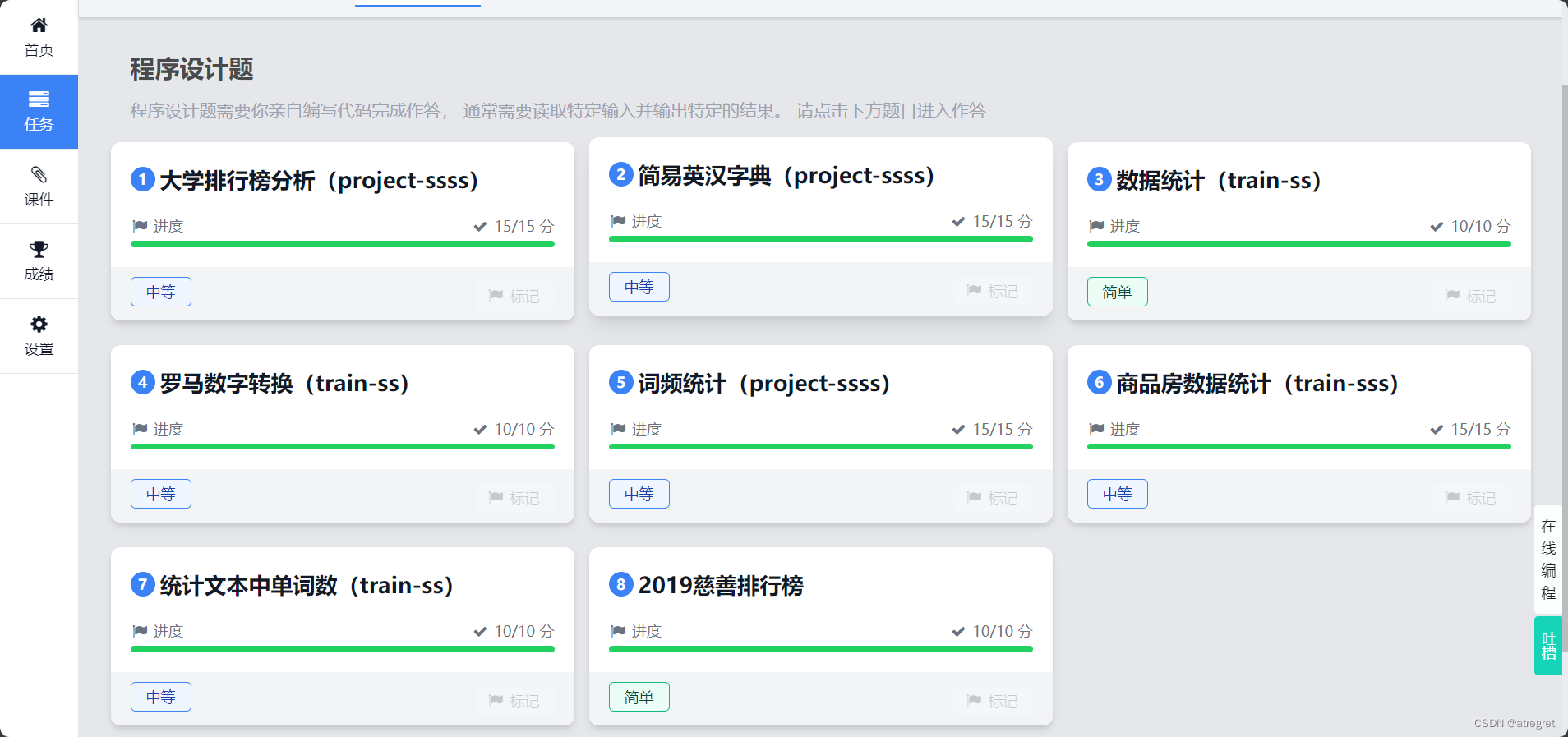一、 概览

二、参考代码
1. 大学排行榜分析 #126373
# -------- ------- --------
# @Author : 赵广辉
# @Contact: vasp@qq.com
# @Company: 武汉理工大学
# @Version: 1.0
# @Modify : 2022/06/13 11:33
# Python程序设计基础,赵广辉,高等教育出版社,2021
# Python程序设计基础实践教程,赵广辉,高等教育出版社,2021
# -------- ------- --------
def read_file(file,m):
"""读文件中的学校名到列表中,返回前m个记录的学校集合"""
with open(file,'r',encoding='utf-8') as f:
a = list(f.readlines())
#print(a)
###########关键代码
ls = [list(i.split())[1] for i in a]
#print(ls)
return ls[0:m]
def either_in_top(alumni, soft):
"""接收两个排行榜前m高校名字集合,
获得在这两个排行榜中均在前m个记录的学校名,按照学校名称排序,
返回排序后的列表
"""
ls = []
for i in alumni:
if i in soft:
ls.append(i)
ls.sort()
return ls
def all_in_top(alumni, soft):
"""接收两个排行榜前m高校名字集合,
获得在两个榜单中名列前m的所有学校名,按照学校名称排序,
返回排序后的列表
"""
t = alumni+soft
s = list(set(t))
s.sort()
return s
def only_alumni(alumni, soft):
"""接收两个排行榜前m高校名字集合,
获得在alumni榜单中名列前m但soft榜单中未进前m的学校名,
按照学校名称排序,返回排序后的列表
"""
ls = []
for i in alumni:
if i not in soft:
ls.append(i)
ls.sort()
return ls
def only_once(alumni, soft):
"""接收两个排行榜前m高校名字集合,
获得在alumni和soft榜单中名列前m,但不同时出现在两个榜单的学校名,
按照学校名称排序,返回排序后的列表
"""
ls = []
for i in alumni:
if i not in soft:
ls.append(i)
for i in soft:
if i not in alumni:
ls.append(i)
ls.sort()
return ls
def judge(n):
if n in '1234':
m=int(input())
alumni_set = read_file('./alumni.txt',m)
soft_set = read_file('./soft.txt',m)
if n=='1':
either_rank = either_in_top(alumni_set, soft_set)
print(f'两榜单中均名列前{m}的学校:')
print(either_rank)
elif n=='2':
all_rank = all_in_top(alumni_set, soft_set)
print(f'两榜单名列前{m}的所有学校:')
print(all_rank)
elif n=='3':
only_in_alumni_rank = only_alumni(alumni_set, soft_set)
print(f'alumni中名列前{m},soft中未进前{m}的学校:')
print(only_in_alumni_rank)
elif n=='4':
alumni_soft_rank = only_once(alumni_set, soft_set)
print(f'不同时出现在两个榜单前{m}的学校:')
print(alumni_soft_rank)
else:
print('Wrong Option')
if __name__ == '__main__':
num = input()
judge(num)
2. 简易英汉字典 #126645
# -------- ------- --------
# @File : 简易英汉词典.py
# @Author : 赵广辉
# @Contact: vasp@qq.com
# @Company: 武汉理工大学
# @Version: 1.0
# @Modify : 2021/12/06 23:39
# Python程序设计基础,高等教育出版社
# 代码量1.5-2小时
# -------- ------- --------
import string
def create_dict(filename):
"""接收表示文件名的字符串参数,读文件中的单词及释义,以单词为键,其他部分为值创建字典。
多个释义间可能是逗号或空格分隔,但单词与第一个释义间至少有一个空格,
将文件每一行根据空格切分一次,切分结果分别作为键和值创新字典。
返回字典。
"""
### 使用字典推导式!!!
### 或者用二元组列表d = dict([(1,2),(b,9),(a,3)])
with open(filename,'r',encoding='utf-8') as f:
ls=[line.strip().split(maxsplit=1) for line in f]
dic={k:v for k,v in ls}
return dic
def translate(dic, word):
"""接收两个参数,第一个是读文件创建的字典,第二个参数为要查询的单词,字符串
根据文件创建的字典,从中查询单词word,
如果查询单词存在,元组形式返回词与词的释义;
如果查询不存在,返回'这个词我不明白'
"""
word=word.lower()
return word,dic.get(word,'这个词我不明白')
def sentence_to_words():
"""调用此函数时,先输出提示信息'请输入查询的句子:'
用户输入欲翻译的句子
若输入非空时,先将"n't"替换为 ' not'、"'s"替换为 ' is',再将标点符号替换为空格。
根据空格将句子切分为单词的列表,调用translate逐个单词进行翻译。
用户可重复多次输入,每输入一名翻译一句,
若直接输入回车时,输出'查询结束,正在退出...'。然后结束程序。
"""
while 1:
#print('请输入查询的句子:',end='')
s=input('请输入查询的句子:')
if len(s)==0:
print('查询结束,正在退出...')
break
s=s.replace("n't", ' not')
s=s.replace("'s", ' is')
for x in string.punctuation: # 其他标点符号替换为空格
s = s.replace(x, ' ')
ls=s.split()
for word in ls:
print(" ".join(translate(word_dic,word)))
def translate_word():
"""调用此函数时,先输出提示信息:'请输入查询的单词:'
用户可循环输入欲翻译的单词,若直接输入回车时,输出'查询结束,正在退出...'。
输入非空时输出翻译结果
"""
while 1:
#print('请输入查询的单词:',end='')
word=input('请输入查询的单词:')
if len(word)==0:
print('查询结束,正在退出...')
break
print(' '.join(translate(word_dic,word)))
if __name__ == '__main__':
file = './dict.txt' # 表示文件名的字符串,表示位于当前路径下的'dict.txt'文件
word_dic = create_dict(file) # 调用函数返回字典类型的数据
print('载入字典数据成功!查询单词请输入“1”,查询句子请输入“2”')
choice = input() # 输入操作选项
if choice == '1':
translate_word() # 翻译单词
elif choice == '2':
sentence_to_words() # 翻译句子
else:
print('输入错误,请重新运行程序!')3. 数据统计 #1892
import random
a,b=map(int,input().split())
random.seed(10)
ls = [random.randint(a,b) for i in range(100)]
#[print(i,ls.count(i)) for i in sorted(set(ls))]
for i in range(a,b+1):
if ls.count(i)!=0:
print(i,ls.count(i))4. 罗马数字转换 #72854
d = {'I': 1, 'IV': 3, 'V': 5, 'IX': 9, 'X': 10, 'XL': 30, 'L': 50, 'XC': 80, 'C': 100, 'CD': 300, 'D': 500, 'CM': 800, 'M': 1000}
s = input()
count=0
p=-1
for i in range(len(s)):
if i==p:
continue
if i<len(s)-1 and s[i]+s[i+1] in d.keys():
count+=d[s[i]+s[i+1]]
p=i+1
else:
count+=d[s[i]]
print(count)
5. 词频统计 # 133163
# -------- ------- --------
# @Author : 赵广辉
# @Contact: vasp@qq.com
# @Company: 武汉理工大学
# @Version: 1.0
# @Modify : 2022/06/13 11:33
# Python程序设计基础,赵广辉,高等教育出版社,2021
# Python程序设计基础实践教程,赵广辉,高等教育出版社,2021
# -------- ------- --------
import string
def read_file(file):
"""接收文件名为参数,将文件中的内容读为字符串,
只保留文件中的英文字母和西文符号,
过滤掉中文(中文字符及全角符号Unicode编码都大于256)
将所有字符转为小写,
将其中所有标点、符号替换为空格,返回字符串
"""
with open(file, 'r', encoding='utf-8') as f:
txt = f.read()
s=''
for c in txt:
if ord(c)>256:
s=s+''
elif c in string.punctuation:
s=s+' '
else:
s=s+c
return s.lower()
def count_of_words(txt):
"""接收去除标点、符号的字符串,统计并返回其中单词数量和不重复的单词数量"""
ls=txt.split()
return len(ls),len(set(ls))
def word_frequency(txt):
"""接收去除标点、符号的字符串,统计并返回每个单词出现的次数
返回值为字典类型,单词为键,对应出现的次数为值"""
ls=txt.split()
dic={k:ls.count(k) for k in set(ls)}
return dic
def top_ten_words(frequency, cnt):
"""接收词频字典,输出出现次数最多的cnt个单词及其出现次数"""
ls = sorted(frequency.items(), key=lambda x: x[1], reverse=True)
for word, counts in ls[:cnt]:
print(word, counts)
def top_ten_words_no_excludes(frequency, cnt):
"""接收词频字典,去除常见的冠词、代词、系动词和连接词后,输出出现次数最多的
cnt个单词及其出现次数,需排除的单词如下:
excludes_words = ['a', 'an', 'the', 'i', 'he', 'she', 'his', 'my', 'we',
'or', 'is', 'was', 'do', 'and', 'at', 'to', 'of', 'it', 'on', 'that', 'her',
'c','in', 'you', 'had','s', 'with', 'for', 't', 'but', 'as', 'not', 'they',
'be', 'were', 'so', 'our','all', 'would', 'if', 'him', 'from', 'no', 'me',
'could', 'when', 'there','them', 'about', 'this', 'their', 'up', 'been',
'by', 'out', 'did', 'have']
"""
excludes_words = ['a', 'an', 'the', 'i', 'he', 'she', 'his', 'my', 'we',
'or', 'is', 'was', 'do', 'and', 'at', 'to', 'of', 'it', 'on', 'that', 'her',
'c','in', 'you', 'had','s', 'with', 'for', 't', 'but', 'as', 'not', 'they',
'be', 'were', 'so', 'our','all', 'would', 'if', 'him', 'from', 'no', 'me',
'could', 'when', 'there','them', 'about', 'this', 'their', 'up', 'been',
'by', 'out', 'did', 'have']
for k in excludes_words:
frequency.pop(k)
ls = sorted(frequency.items(), key=lambda x: x[1], reverse=True)
for word, counts in ls[:cnt]:
print(word, counts)
# 取消这段和代码最后二行注释可以绘制词云,仅供参考
# def draw_cloud(frequency):
# """绘制词云,传入参数为词频,设定图片的宽度600,高度400,背景白色、字体最大值150、图片边缘为5。"""
# wc = WordCloud(max_words=80, # 设置显示高频单词数量
# width=600, # 设置图片的宽度
# height=400, # 设置图片的高度
# background_color='White', # 设置背景颜色
# max_font_size=150, # 设置字体最大值
# margin=5, # 设置图片的边缘
# scale=1.5) # 按照比例进行放大画布,如设置为1.5,则长和宽都是原来画布的1.5倍。
# wc.generate_from_frequencies(frequency) # 根据文本内容直接生成词云
# plt.imshow(wc) # 负责对图像进行处理,并显示其格式,但是不能显示。
# plt.axis("off") # 不显示坐标轴
# wc.to_file('My Cheese.png') # 词云保存为图片
# plt.show() # 显示图像
if __name__ == '__main__':
filename = 'Who Moved My Cheese.txt' # 文件名
content = read_file(filename) # 调用函数返回字典类型的数据
frequency_result = word_frequency(content) # 统计词频
cmd = input()
if cmd == '1':
n = int(input())
print(content[:n])
elif cmd == '2':
amount_results = count_of_words(content)
print('文章共有单词{}个,其中不重复单词{}个'.format(*amount_results))
elif cmd == '3':
n = int(input())
top_ten_words(frequency_result, n)
elif cmd == '4':
n = int(input())
top_ten_words_no_excludes(frequency_result, n)
# frequency_no_excludes = top_ten_words_no_excludes(frequency_result)
# draw_cloud(frequency_no_excludes)
6. 商品房数据统计 #136866
with open('wuhan2021s1.csv','r',encoding='GBK') as f:
ls=[line.strip().split(",")for line in f][1:]
district={x[1] for x in ls}
lss=ls
n=input()
if n=="规模升序":
lss.sort(key=lambda x:eval(x[-1]))
for line in lss:
print(" ".join(line))
elif n=="规模降序":
lss.sort(key=lambda x:eval(x[-1]),reverse=True)
for line in lss:
print(" ".join(line))
elif n in district:
lss=[x for x in ls if x[1]==n]
for line in lss:
print(" ".join(line))
print("{:.2f}平方米".format(sum([eval(x[-1]) for x in lss])))
elif n=="总规模":
print("{:.2f}平方米".format(sum([eval(x[-1]) for x in ls])))
else:
print("错误输入")7. 统计文本中单词数 # 2545
file=input()
with open(file,'r',encoding='utf-8') as f:
txt=f.read()
for c in '!"#$%&()*+,./:;<=>?@[\]^_{|}~\n':
txt=txt.replace(c," ")
print(len(txt.split()))8. 2019慈善排行 # 114813
with open("2019Charity.csv","r",encoding="utf-8")as f:
ls=[line.strip().split(",") for line in f][1:]
province={x[3] for x in ls}
s=input()
if s.lower()=="total":
lss=[eval(x[-1])for x in ls]
print('Total:{}万元'.format(sum(lss)))
elif s.isdigit() and int(s) in range(1,101):
lss=[x for x in ls if x[0]==s]
for line in lss:
print(" ".join(line))
elif s in province:
lss=[x for x in ls if x[-3]==s]
for line in lss:
print(" ".join(line[:4]))
else:
print("No Record")





















 1294
1294

 被折叠的 条评论
为什么被折叠?
被折叠的 条评论
为什么被折叠?








